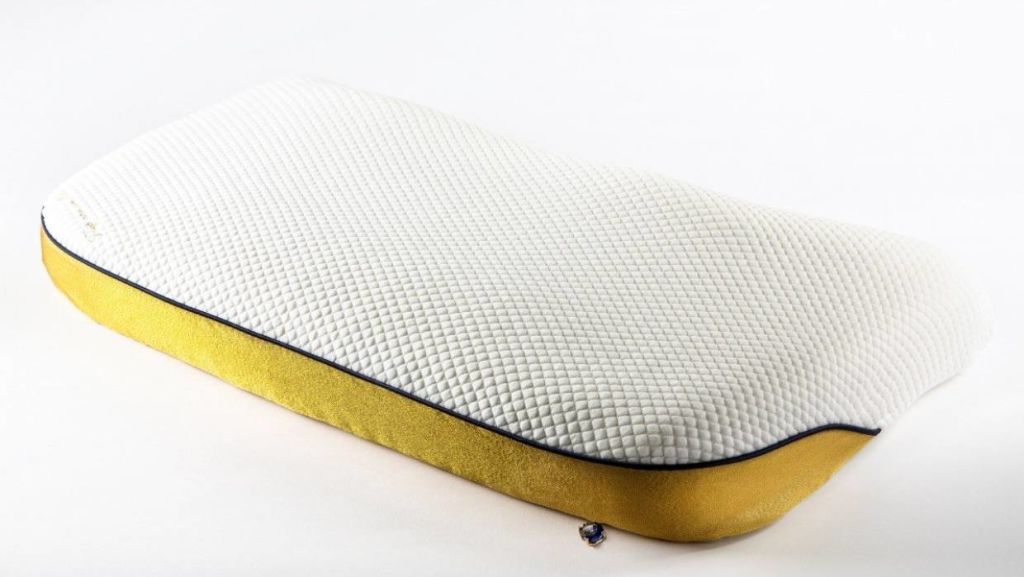The world's most expensive pillow is $82k, but does that make it the best?

Encrusted with gems and trimmed with 24-carat gold-infused fabric, neck specialist Thijs van der Hilst’s Tailor Made Pillow is the queen of pillows.
Its ergonomic shape is bespoke, taken from a digital scan of your head and neck. It is 3D printed, and hand finished, with four diamonds and an intimidatingly large 22.5ct sapphire in the zip, because, why not?
It’s also $82,000 – about the same price as a new Mercedes-Benz GLA 250, or a healthy deposit for a house. Suddenly that $289 Ecosa hypoallergenic goose down pillow you dearly want, but can never bring yourself to shell out for, seems entirely reasonable.

With so many options and prices to choose from – goose, latex, memory foam, synthetic – picking a place to lay your head has become a fraught business. But is all this mania for high-end things to drool on actually necessary? Is there anything an expensive pillow can give you that a bog standard $15 fluff bag can’t?
According to sleep expert Jane Wigglesworth, of How To Sleep Well, there’s at least one good, scientific reason to avoid spending nearly $90k – or even $200 – on a pillow: you need to replace them every two years.
“You should be replacing it that often for two reasons: firstly, because dust mites build up and they build up by their millions, and two, because they wear out over time and they won’t be as supportive,” Wigglesworth said.
“Honestly, you’ve got billions of dust mites loading up in that pillow, and after two years you’ve got to get rid of that. Quite a high level of the population is allergic to dust mites.”

The dust mite issue is bad, according to Allergy spokesman Mark Dixon.
“The main allergy that you’re looking to provide some protection from [when you choose your pillow] is dust mites,” says Dixon.
“They’re a little bug that’s invisible to the human eye, very, very small, but breed in very high numbers. They feed on dust, and the allergy that people have to dust mites is to the protein in their dead bodies and their faecal matter, their waste. It’s not as horrifying as it sounds because it’s all invisible, so we don’t see it. But the thought’s not great.”
No kidding. Be right back; I just have to duck home and set all my bedding on fire.
Otago University’s David Baxter, who researches alternative methods of treatment for musculoskeletal conditions and tissue repair, says his personal view is that the “evidence for customised pillows is not strong”.
“It is hard to make a definitive recommendation for a specific type of pillow. In general, routine clinical advice would be to get a pillow that is comfortable for the individual and gives adequate support to the head and neck.”

Wigglesworth agrees, saying that while your pillow is “an investment in high-quality sleep”, picking the right one is all about your specific, individual needs, it doesn’t always follow that paying the big bucks will get you the perfect pillow.
“You don’t necessarily need a $300 pillow. I can tell you I have neck issues and my one was like $25, and I love it.
“The best pillow is really the one that feels comfortable to rest on. It can be really, really tricky to find the one that suits you, so it’s best to look at the different types of pillows that there are around.
“The cheap synthetics filled pillows will only last about a few months so even though they’re cheap you will need to replace them regularly.
“That might be fine for some people, you know if you’re going to the beach house and you wanted some extra pillows to take they would be perfect. And they’re good for people who have allergies to down and feather pillows, but they are subject to dust mites. They are washable, but as far as neck support goes, they’re definitely not the one to get for you.”
Registered musculoskeletal clinical specialist Steve Tumilty says the problem is that no two people are built the same, and no one stays in the same sleeping posture throughout the night.
“A pillow that provides the correct posture and support when lying on your back wouldn’t necessarily be the right size and shape for when you were lying on your side. The pillow should support your neck and shoulders to be relaxed in a neutral posture regardless of whether you are lying on your side or your back.

“As for the expense; in my experience, it comes down to the quality of the materials and how long they would last before losing their structure and support. That being said, when it comes to healthcare, a lot of manufacturers charge exorbitant prices because the public thinks they are getting quality. More money doesn’t always correlate with more benefit.
“I would aim to get the best you can afford from the middle of the range of prices. At the moment my pillow at home cost me $20, I’ve had it for over a year, and it is outperforming others that I have paid a lot more for.”
So what are the pluses and minuses of the types of pillows available? Wigglesworth outlines four:
Down: “They lack adequate support if you’re someone that has neck pain. But for some people, they absolutely love the softness. They can bunch it up, and they just love it. But if you’ve got neck pain or an allergy to down and feathers, this is not the one.”
Wool: “They are great because they’re hypoallergenic they repel mould and dust mites. Wool also wicks away moisture from your head and neck, and that can help regulate your temperature during sleep, it keeps you warm in the winter and cooler in summer. This is probably pretty good for someone who’s menopausal, who get’s very hot at night.
“They can be pretty firm pillows so if you don’t like a firm pillow, this might not be good for you, but they are pretty supportive.
“An alternative might be an alpaca wool pillow. They are hypoallergenic; they’re a little bit softer than the typical wool pillows you might get. If you want a little bit of support and you need a hypoallergenic pillow, this could be one for you.”
Memory foam: “They can be very expensive, but they are made of polyurethane [so no dust mites or mould]. They’ve got a lot of added chemicals in them so when you first buy them some of them stink; you need to air them. Some people react to the chemicals as well.
“They are comfortable because they mould to your shape. Just a little bit of body heat and it moulds very quickly to your neck and head so they can be very comfy and good for neck pain as they are very supportive. But they trap the heat so they can be very, very warm in summer.”

Wigglesworth’s pick, however, is the latex pillow.
“They don’t mould like memory foam, but they have a little bit of give, and they don’t squish up like synthetic or down pillows. Latex is also resistant to mould and dust mites, so it’s a great one if you have allergies to that.
“You can get the contoured ones as well, which deliver extra support to head and neck. It’s ideal if you’ve got neck and back pain as it offers really good support and it’s fairly soft as well. They can range in prices, be really expensive or really cheap.”
Some folk do have an allergy to latex as well, so would need to check that out before committing to buy a latex pillow.
One thing Wigglesworth is firm about, however, is the need for the right pillow for you.

“You might not realise that that’s what’s keeping you awake, or might wake you up several times in the night.
“[With the wrong pillow] you’re just not in a comfortable position, you might not have major pain, but you’re moving around a lot and your body’s just not getting comfortable, or it’s not in the right posture and these little uncomfortable positions are going to wake you. You might not actually realise that is why it’s happening. You really do need a supportive pillow.”
How to pick the best pillow for you according to Wigglesworth and Tumilty:
- Try it out in the shop if possible; lying on your back and on your side.
- Take it home for a trial – you might be able to if you keep the pillow in its plastic wrapper
- It should be comfortable to the individual and give support.
- The neck and shoulder muscles should be relaxed when lying on the pillow (tension should leave those muscle groups).
- The spine, including head posture, should be in a neutral position.
A final tip for a good night’s sleep is to keep your head cool and your feet warm.
We recommend
We thought you might like
States
Capital Cities
Capital Cities - Rentals
Popular Areas
Allhomes
More
- © 2025, CoStar Group Inc.








